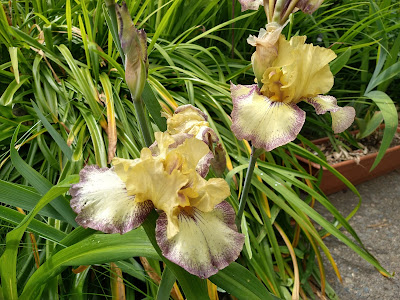Dig and divide now for more irises next spring

These are Tennessee Gentleman irises. Divide andreplant irises every three to five years for bestproduction. (Photo: Debbie Arrington)
Bearded irises need late-summer rejuvenation to keep blooming

By Debbie Arrington
Have your bearded irises stopped blooming? When was the last time you dug them up?
Every three to five years, bearded irises need to be dug up and started over. That’s the key to their durability and consistent bloom.
Each thumb-like growth on the rhizome – the plant’s fleshy underground stem – only flowers once. The rhizome then grows and produces another thumb, which will bloom the next year. But if the rhizomes run out of room to grow, they stop blooming.
Timing is everything with this chore; irises need to be divided and replanted in late August or September to get ready for spring bloom. So, now is the right time to dig up the iris bed.
Why grow irises? They’re among the best water-wise perennials for the greater Sacramento area. They’re low maintenance, drought tolerant and reliable. Deer won’t eat them and most pests leave them alone. They pretty much take care of themselves most of the year, dying back in fall before re-emerging for a massive spring flower show.
What you see above ground is tied directly to what’s below ground. Over time, iris rhizomes lose their vitality. They rot or wither away. Side shoots grow from the central rhizome to form new baby rhizomes. It’s those baby rhizomes that will produce the future blooms.
Fans of leaves sprout from the tips of those thumbs. Since those thumbs can bloom only once, discard any segments attached to flower stalks when dividing iris.
How do you know which to keep, which to cut? Dig up the rhizomes and look.
Shallow-rooted, they come up very easily, pried from the ground with a pitch fork or spade.
Once they're unearthed, wash the rhizomes off with water and start working them apart, using your fingers and a trowel or sharp knife. Keep the young healthy rhizomes with one or two fans of leaves and healthy roots attached. Break off the aged, bloomed-out, rotted or dried-out pieces and discard. Also look for insect damage; cut that out, too. Of the fans you keep, trim the leaves down to 4 to 6 inches.
Now you’re ready to replant. Rejuvenate the planting area with some well-aged compost and a little bone meal, worked into the top 6 inches of soil. (That’s going to be all the fertilizer the irises need for the next three to five years.)
Plant the rhizomes about 12 inches apart so the fan of leaves sits right on the soil surface, with the rhizome just under the soil. The rhizome will grow in the direction the fan is facing (with the curve of leaves to the outside); position plants accordingly so they have room to spread and sprout new flower stalks.
Unlike most perennials, don’t cover with mulch. (That can promote rhizome rot.) Water deeply once, then let rest.
Want to learn more about irises? Check out the Sacramento Iris Society: https://sacramentoirissocietydotcom.wordpress.com/


Comments
Post a Comment